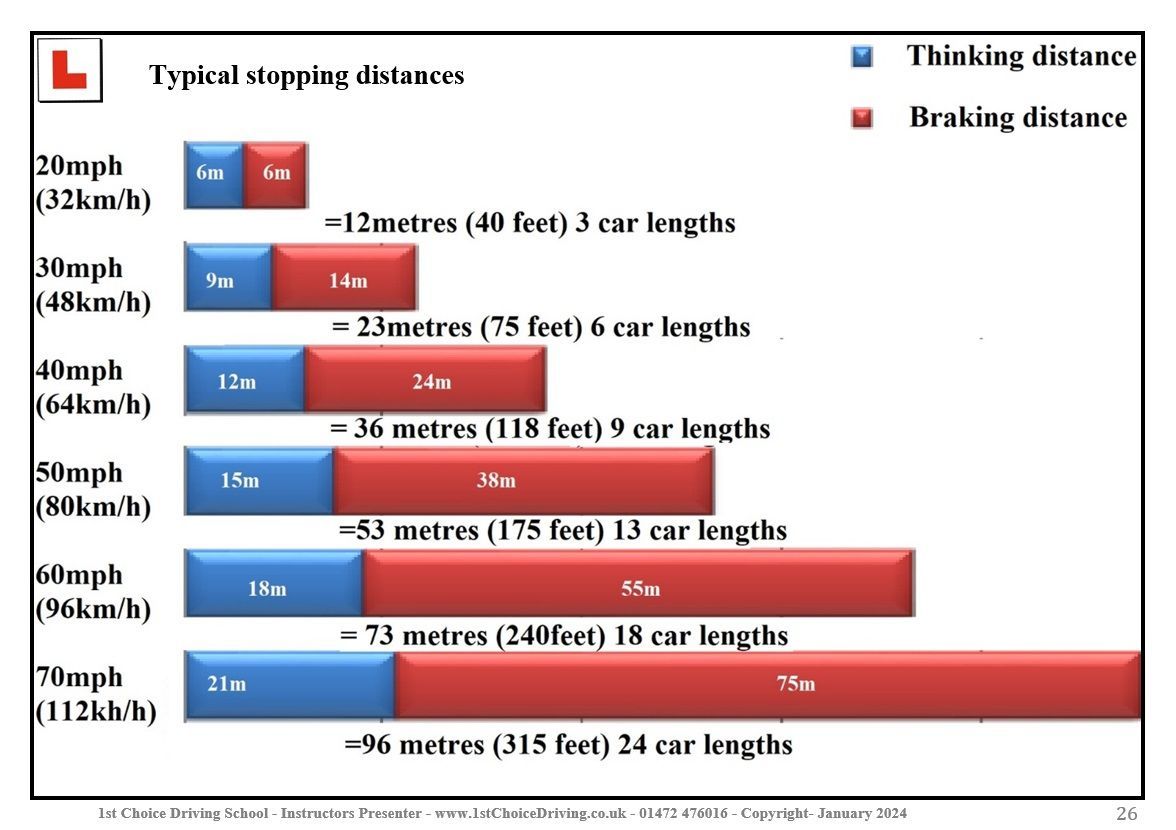- You will be moving off using the P.O.M routine
- Pulling away with clutch control
- M.S.M/P.S.G & L.A.D.A routine's when stopping, turning, emerging at junctions will be improving
- Co-ordination of foot controls will be fluent
- Steering/pulling when parking up on the left also turning and emerging at junctions will be improving
- Gear changing up and down should now be independent
- Adequate distance around stationary vehicles and slower moving vehicle (cyclists and pedestrians) should be nicely improving.
- L.A.D.A & M.S.P.S.G (at junctions)
- Two second gap
- Hold back position
- Meeting , overtaking, adequate clearance when overtaking stationary & slow moving vehicles Continue working on open & closed junctions
- Junction work
- Full talk through
- Prompt
- Independent.
At the training location
One learner out of three to get the emergency stop exercise on a driving practical test.
Your examiner will pull you up on the left hand side of the road at some part of your driving test, then will explain to you the following once you have pulled over:-
- I would like you to demonstrate the emergency stop exercise
- Before I give you the instruction, I will look over my right shoulder to ensure its safe to give you the instruction and my verbal instruction will be to STOP!
- Please DO NOT anticipate the examiner will say STOP as soon as they look over their shoulder.
Then the examiner will ask you to drive on when it is safe to do so.
Before you drive on and start the exercise.
- P.O.M up and drive on when it is clear behind you.
- When you get your speed up to about 20/30mph you will be given the instruction of "STOP"!!
- At this point you DO NOT need to check any of your mirrors (as you should be checking them every 6-10 seconds) as you should know what is behind you before you pulled away to do the emergency stop.
You need quick reactions to stop safely whilst maintaining full control of your vehicle
The correct use and tempo of pedals
Remember A, B and C.
- Come off your Accelerator
- Squeeze your Brake
- Clutch down
Engine braking
- If you press the clutch first your training vehicle no longer has engine braking as you have separated the engine and gearbox. Therefore there will be no engine/gearbox breaking so it will probably take longer to stop and may become difficult to control.
Timing of reactions to your pedals
An easy way to get the timing right is by Saying STOP in your head and when you are told to stop.
Press the foot brake on the S and press the clutch pedal down on the P, giving you a method to stop with the correct use of pedals.
What you will be assessed on when stopping:-
- The overall time it has taken you to stop
- The correct use of the brake and the clutch
- Correct control (so you DO NOT skid)
- Placement of your hands throughout the exercise
Once you have stopped
Apply your handbrake and put your gearstick into neutral
Then once the vehicle has stopped you will be asked to drive on
Preparing to drive on
Make sure you do your P.O.M routine.
- Prepare with 1st gear.
- Observe all around including the left and right blind spots.
- Move (drive on) when it is safe to do so.
Take extra observations before moving away checking both blind spots.
Additional information
Keep both hands on the steering wheel until the car has stopped, this will help keep control of the vehicle when you brake firmer as usual (as the weight of the car is thrown forwards due to the engine’s weight).
Hold the steering wheel with a firm grip this will help to maintain direction or correct skids if one occurs.
Do you know what is ABS?
Answer - Anti-lock Braking System (ABS)

- Agree learning goals and needs of todays lesson
- Agree appropriate lesson structure (full, partially or independent level of instruction)
- Practice in a suitable training area
- Agreed if needed to adapt the lesson plan to help the pupil work towards their new learning goals if any verbal or physical intervention was made by the instructor
- Directional instructions will be given in ADI format (Alert, direction and identify manor) given to the pupil clear and given in good time
- Agree if the students made a minor, serious or dangerous error on your lesson it will be broken down using F.I.S.H (fault, implications, solution & help) this method of feedback helps pupils understand what fault is being made and how to strategies on how correct the faults.



